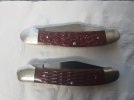I've tried to add jigging to wood, plastic (delrin, I think), and bone scales. I've used various tools, including the tip of knife blade, rotary tools, and (of all things) the tip of the package opener on the Leatherman Wingman. I wasn't really happy with any of the results.
Here are some tips that I learned from my jigging attempts:
It takes a very careful, light touch with a a rotary tool to avoid cutting too deep or long. Try to keep your cuts shallow and short at first; you can always make them deeper later.
It's a good idea to mark out your jigging pattern on the scale before you start cutting. Even if you're aiming for an "irregular" pattern, you can still plan it out to look aesthetically pleasing. The first time I tried jigging, I didn't think to plan it out, I didn't consider how close together the cuts should be, and some of the troughs and grooves that I cut merged together. The resulting gouges and troughs looked more like chewing marks than a jigging pattern.
Hand tools (especially those not intended for bone) can slip on bone and leave scratches where you didn't want them, or even stab into your other hand.
My recommendation is to start by practicing (or developing) your jigging technique on sacrificial materials (like scrap wood) before you try it on your knife's scales. Wood will behave differently from bone because it's usually softer, but it's easier to find than bone. Both materials have a similar grain structure and you'll learn which rotary tool attachments work best, how to angle your cuts to work with the grain, how long and deep to make each cut, how close together the cuts should be, etc.

